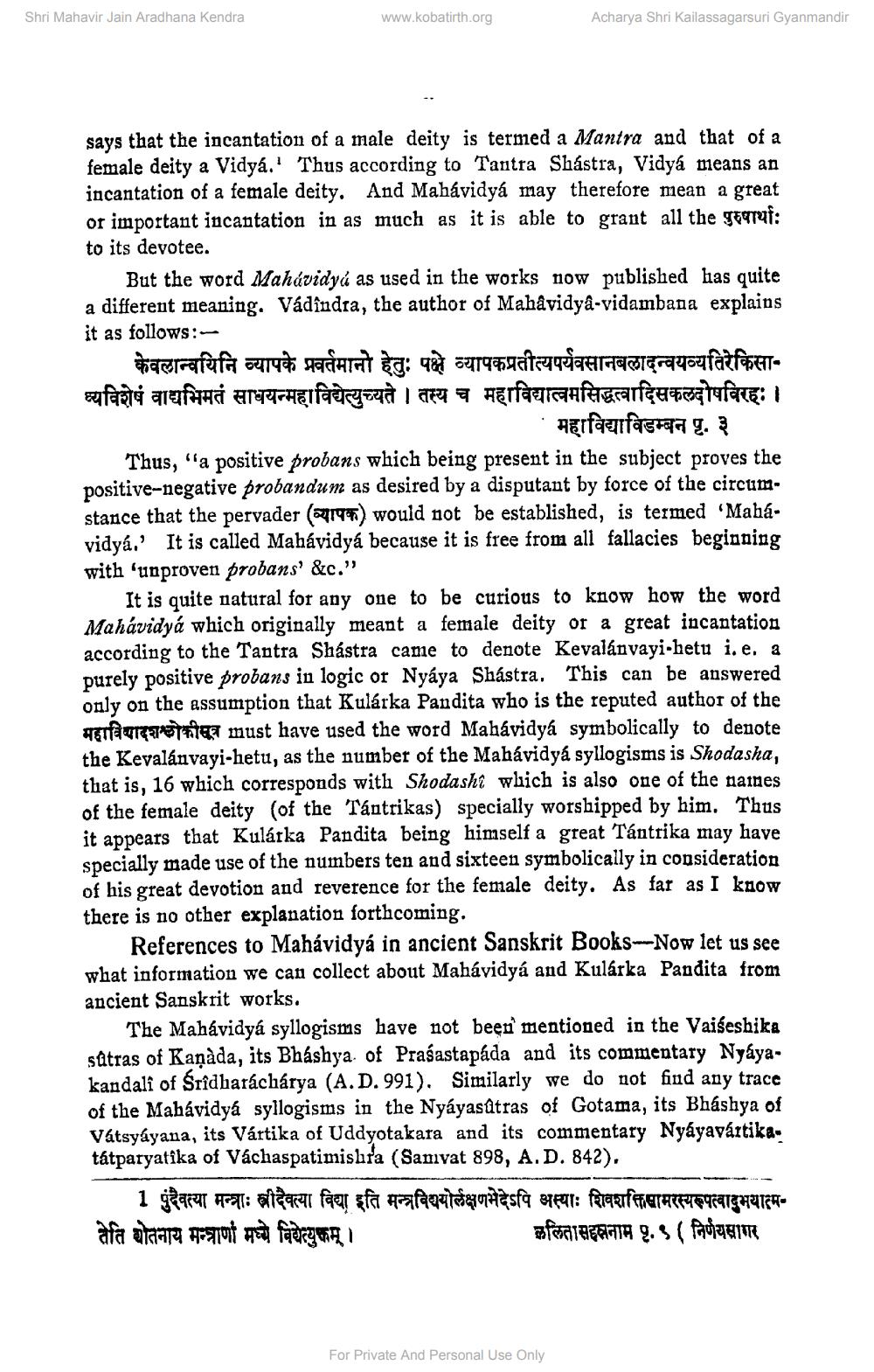________________
Shri Mahavir Jain Aradhana Kendra
www.kobatirth.org
Acharya Shri Kailassagarsuri Gyanmandir
says that the incantation of a male deity is termed a Mantra and that of a female deity a Vidya.' Thus according to Tantra Shastra, Vidya means an incantation of a female deity. And Mahavidya may therefore mean a great or important incantation in as much as it is able to grant all the gegraf: to its devotee.
But the word Mahavidyú as used in the works now published has quite a different meaning. Vádîndra, the author of Mahavidyâ-vidambana explains it as follows:
केवलान्वयिनि व्यापके प्रवर्तमानो हेतुः पक्षे व्यापकप्रतीत्यपर्यवसानबलादन्वयव्यतिरेकिसाध्यविशेषं वाद्यभिमतं साधयन्महाविद्येत्युच्यते । तस्य च महाविद्यात्वमसिद्धत्वादिसकलदोषविरहः ।
. Herfanfassen g. 3 Thus, "a positive probans which being present in the subject proves the positive-negative probandum as desired by a disputant by force of the circumstance that the pervader (21194) would not be established, is termed "Mabávidya.' It is called Mahávidya because it is free from all fallacies beginning with 'unproven probans' &c."
It is quite natural for any one to be curious to know how the word Mahavidya which originally meant a female deity or a great incantation according to the Tantra Shastra came to denote Kevalányayi-hetu i.e. a purely positive probans in logic or Nyaya Shastra. This can be answered only on the assumption that Kulárka Pandita who is the reputed author of the agilagree must have used the word Mahávidya symbolically to denote the Kevalánvayi-hetu, as the number of the Mahávidya syllogisms is Shodasha, that is, 16 which corresponds with Shodashi which is also one of the names of the female deity of the Tántrikas) specially worshipped by him. Thus it appears that Kulátka Pandita being himself a great Tántrika may have specially made use of the numbers ten and sixteen symbolically in considerat of his great devotion and reverence for the female deity. As far as I know there is no other explanation forthcoming.
References to Mahávidya in ancient Sanskrit Books --Now let us see what information we can collect about Mahavidya and Kulárka Pandita from ancient Sanskrit works.
The Mahavidya syllogisms have not been mentioned in the Vaiseshika sâtras of Kaņàda, its Bhashya. of Prasastapáda and its commentary Nyayakandali of Sridharáchárya (A.D. 991). Similarly we do not find any trace of the Mahavidya syllogisms in the Nyayasatras of Gotama, its Bháshya of Vátsyayana, its Vártika of Uddyotakara and its commentary Nyáyavártika. tátparyatika of Váchaspatimishra (Saniyat 898, A. D. 842).
1 पुंदैवत्या मन्त्राः स्त्रीदैवत्या विद्या इति मन्त्रविद्ययोर्लक्षणभेदेऽपि अस्याः शिवशक्तियामरस्यरूपत्वादुभयात्मतेति योतनाय मन्त्राणां मध्ये विद्येत्युक्तम् ।
कलितासहस्रनाम पृ. ९ ( निर्णयसागर
For Private And Personal Use Only




